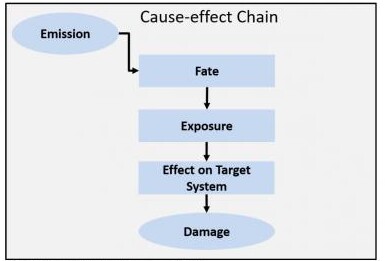Understanding the Life Cycle Impact Assessment Process: Part II – Modeling Exposure: Intake and Bioavailability
Life Cycle Impact Assessment (LCIA) is a central element of Life Cycle Assessment (LCA) -- the point in the LCA process where potential environmental impacts of a product or service are identified and quantified.

Life Cycle Impact Assessment (LCIA) is a central element of Life Cycle Assessment (LCA) -- the point in the LCA process where potential environmental impacts of a product or service are identified and quantified.
Exhibit 1: Cause-effect chain for modeling environmental impactsThis is part two of a three-part series that reviews the three distinct phases of LCIA impact modeling (fate, exposure, and effect (Exhibit 1)), and explains how they build on one another to create a usable picture of environmental impacts for use in broader analyses.
As discussed in Part I, the LCIA process uses mathematical models to predict the possible outcomes of an upstream decision. These models can mimic the natural processes the emission will go through -- and the impact it will have on human health and plant and animal species.

We’ve already reviewed the use of fate modeling to account for the characteristics of an emission and the environmental concentration it forms once released. With this information in hand, we can move on to exposure modeling, which looks at the intake level of the emission by considering various routes and modes of intake; for ecosystems, exposure models consider the amount of the emission that becomes bioavailable. (Our upcoming Part III will look at modeling of effects of the intake by organisms.)
An exposure factor for a pollutant links the fate factor to the intake level (for humans) or the amount that becomes bioavailable (for other organisms) via a specific environmental medium (air, water or soil).
For humans, exposure can occur through various routes, including inhalation, ingestion and absorption through skin (Exhibit 2). Modeling of exposure through water and soil can be more complex than exposure through air, simply because of the large variety of food and drink that humans consume. Generally, exposure to pollutants in water occurs through direct consumption of the water, or indirectly through consumption of seafood. For pollutants in soil, exposure can occur through food or direct ingestion or inhalation of dust.
Exhibit 2: Exposure routes for humans

Equation 1: Expressions for calculating human and ecosystem exposureTo model exposure pathways as accurately as possible, current toxicity models include a wide range of foods including most grains, fruits, vegetables, dairy products, meat and fish. The expressions in Equation 1 can be used to calculate exposure for humans and ecosystems.
We will wrap up our discussion of LCIA in the upcoming Part III of this series, with a look at effect modeling – the stage where we connect our exposure data to known toxicity data, and estimate the adverse effects at given exposure levels.
We hope you’re finding this discussion of LCIA useful; if you have questions or comments, please feel free to post them below!
For full information about sources referenced in this series, please visit our LCIA Bibliography.
For more information on impact assessment methods and models, please see the free online course on impact assessment and the free brown bag webinars offered by EarthShift Global.